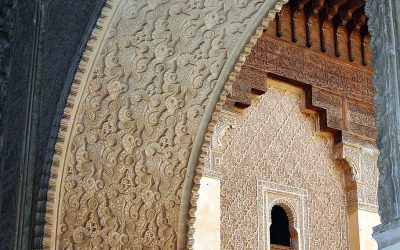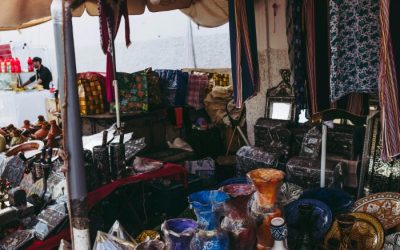History of the Moroccan Flag
The flag of Morocco is a symbol rich in history and cultural significance, representing the nation’s heritage and identity. Its distinctive design, featuring a green pentagram on a red background, reflects centuries of tradition and symbolism rooted in Islamic culture and Moroccan history. Over the years, the flag has evolved to become an enduring emblem of national pride and unity for Moroccans worldwide.
Origins and Early Designs
The flag of Morocco features a distinctive green five-pointed star, known as the Seal of Solomon, centered on a red background. Its history dates back to the early 20th century, reflecting the nation’s rich cultural and religious heritage. The red color has long been associated with the Moroccan monarchy and Arab-Islamic identity, symbolizing strength, bravery, and valor. The green pentagram, added officially in the early 20th century, represents wisdom, peace, and the connection to Islamic tradition. Throughout its early history, various designs incorporated different symbols and colors, but the red field with the green pentagram was solidified as the official national flag in 1915 during the French protectorate period. The design was influenced by historical banners used by Moroccan dynasties, and it has remained largely unchanged since then, embodying the nation’s historical pride and Islamic identity.
Evolution Through History
The flag of Morocco has a rich history rooted in its cultural and political evolution. Throughout centuries, it has reflected the nation’s identity, sovereignty, and Islamic heritage, undergoing several changes to reach its current design.
The earliest known flags used in Morocco date back to the medieval period, where banners displayed during battles or royal ceremonies often featured symbols such as the crescent moon and stars, indicative of Islamic influence. During the Idrisid dynasty (8th to 10th centuries), flags were primarily banners with plain colors, serving as symbols of authority.
The modern design of the Moroccan flag was officially adopted in 1915 during the French protectorate era. This flag featured a green pentagram, known as the Seal of Solomon, on a red background. The red color has historic significance, symbolizing strength, bravery, and the ruling family, while the green pentagram represents wisdom and the link between God and the nation.
Post-independence in 1956, Morocco retained the red flag but maintained the green pentagram as its central emblem. Over time, the design has remained consistent, symbolizing the country’s rich Islamic culture and monarchy. The flag’s simplicity and profound symbolism make it a distinctive national symbol recognized worldwide.
- 8th-10th centuries: Banners with Islamic symbols used during early dynasties.
- 1915: Adoption of the official flag featuring a red background with a green pentagram.
- 1956: Morocco gains independence, keeping the same flag design.
- Present day: The flag continues to symbolize Moroccan identity, faith, and sovereignty.
Modernization and Standardization
The flag of Morocco has a rich history that reflects the nation’s cultural identity and political evolution. Its origins can be traced back to the use of banners and emblems representing Moroccan dynasties and Islamic heritage. The current design, featuring a green pentagram on a red background, was officially adopted in 1915 during the French protectorate period, symbolizing strength, dignity, and the Islamic faith of the Moroccan people.
Throughout history, the flag has undergone various modifications, but the red field has remained consistent as a symbol of bravery and have served as a link to Morocco’s Moorish roots. The green pentagram, also known as the Seal of Solomon, was added to represent wisdom, life, and the connection to Islamic traditions, which are central to Moroccan identity.
Modernization and standardization efforts have focused on establishing clear specifications for the flag’s dimensions and color shades to promote national unity and sovereignty. Over the years, official guidelines have been developed and updated to ensure consistency in the flag’s appearance during official ceremonies, international events, and everyday use. This process has helped solidify the flag as a unifying national symbol that embodies Morocco’s historical legacy and contemporary identity.
Design and Symbolism
The flag of Morocco is a powerful symbol of the nation’s history, culture, and identity. Its design incorporates meaningful elements that reflect the country’s rich traditions and heritage. Examining the symbolism within the flag provides insight into Morocco’s values and the stories that have shaped its identity over centuries.
Main Features of the Flag
The flag of Morocco is a prominent national symbol that reflects the country’s rich history and cultural heritage. Its design features a red field with a green pentagram, known as the Seal of Solomon, in the center. The red background signifies strength, bravery, and the unity of the Moroccan people, while the green pentagram symbolizes wisdom, peace, and the connection to Islam. The five points of the star are said to represent the five pillars of Islam, emphasizing Morocco’s religious significance. The overall design represents national pride and the country’s enduring traditions, making the flag a powerful emblem of Morocco’s identity.
Meaning of the Colors
The flag of Morocco is rich in design and symbolism, reflecting the country’s cultural and historical identity. Its primary feature is a green five-pointed star, known as the pentagram or Seal of Solomon, set against a red background. The red color symbolizes strength, bravery, and valor, historically associated with the Moroccan monarchy and Arab dynasties. The green star represents Islam, which is the dominant religion in Morocco, and also signifies wisdom, hope, and joy. The five points of the star are said to stand for the five pillars of Islam, emphasizing the nation’s religious foundation. Overall, the flag’s design and colors serve as a proud emblem of Morocco’s heritage, faith, and resilience within the Islamic world and beyond.
Significance of the Star
The star on the Moroccan flag, known as the Seal of Solomon or the pentagram, holds deep symbolic meaning rooted in history and culture. It represents wisdom, protection, and spiritual insight, reflecting the country’s rich heritage and Islamic influence. The green color of the star is often associated with Islam, fertility, and nature, emphasizing Morocco’s religious and cultural identity. The five points of the star symbolize the pillars of Islam, underscoring the importance of faith and unity among Moroccans. Overall, the star is a powerful emblem that unites the nation and signifies hope, guidance, and the pursuit of peace. Its prominent placement on the red background highlights Morocco’s strength, bravery, and resilience throughout history.
Colors and Their Significance
Colors play a vital role in language, conveying emotions, cultural meanings, and symbolizing identities. In the context of national symbols like flags, colors are especially significant, representing the history, values, and heritage of a country. The flag of Morocco, for example, prominently features colors that embody its cultural identity and historical symbolism, making it a powerful emblem of national pride.
Red Background
The red background of the Moroccan flag holds deep cultural and historical significance. Red has traditionally been associated with strength, bravery, and valor, symbolizing the resilience of the Moroccan people throughout history. It also reflects the Moorish influence and the legacy of the Alaouite dynasty, underscoring sovereignty and national pride. The vibrant hue serves as a unifying element, inspiring unity and patriotism among Moroccans, while also standing out as a distinctive and recognizable symbol on the global stage.
Green Pentagram
The flag of Morocco features a striking green pentagram, also known as the Seal of Solomon, set against a vibrant red background. The green color on the flag symbolizes Islam, which is the predominant religion in the country, as well as hope and joy. The red color represents strength, bravery, and valor, reflecting Morocco’s rich history and resilience. The green pentagram holds spiritual significance, representing wisdom and peace, and is a symbol of harmony and the connection between the divine and the earthly. Overall, the colors and symbols on the Moroccan flag embody the nation’s cultural identity, religious foundations, and historical values.
Color Symbolism in Moroccan Culture
The flag of Morocco is a vibrant symbol deeply rooted in the country’s rich cultural heritage, with colors that carry significant meaning. The bright red background represents strength, bravery, and valor, reflecting Morocco’s history of resilience and independence. The green pentagram star, known as the Seal of Solomon, symbolizes peace, wisdom, and the connection between God and the nation. Green in Moroccan culture is also associated with Islam, spirituality, and fertility, making it a sacred color. Red is considered protective and auspicious, often used during celebrations and important events. The combination of these colors in the Moroccan flag embodies national pride, spiritual harmony, and the enduring spirit of the Moroccan people.
Protocol and Regulations
Protocols and regulations play a vital role in ensuring the proper display, respect, and preservation of national symbols such as flags. In the case of Morocco, these guidelines help maintain the dignity of the Moroccan flag, which is a significant emblem of the country’s identity and heritage. Understanding the protocols surrounding the flag’s use promotes national pride and ensures its representation aligns with the country’s standards and traditions.
Official Specifications
The flag of Morocco is governed by specific protocols and regulations that ensure its proper display and respect. Official specifications detail the design, colors, proportions, and placement to maintain consistency across all usages. The national flag features a red field with a green pentagram (Five-pointed star) at the center, symbolizing the connection between God and the nation. According to regulations, the proportions of the flag should be 2:3, and the pentagram must be perfectly centered and proportionally sized relative to the overall dimensions. Rules also specify how the flag should be displayed on public buildings, during official ceremonies, and in international contexts, emphasizing respect and dignity. These standards are outlined in official documents issued by Moroccan authorities to preserve the integrity and symbolism of the national emblem. Proper adherence to these protocols promotes national pride and maintains the flag’s esteemed status as a symbol of Morocco’s sovereignty and cultural heritage.
Flag Usage Rules
The flag of Morocco is a symbol of national identity and pride, governed by specific protocols and regulations to ensure proper display and respect. It features a red background with a green pentagram or five-pointed star in the center, representing the Seal of Solomon, which signifies wisdom and harmony.
According to flag usage rules, the Moroccan flag should be hoisted on official occasions, government buildings, and during national celebrations. When displayed alongside other flags, it should be positioned to the right of the observer or at the center if on a single flagpole. The flag must be handled with dignity, avoiding any disrespect or desecration, such as dragging it on the ground or using it as clothing or decoration inappropriately.
Regulations specify that the flag should be kept in good condition, replacing it if it becomes damaged or faded. During the raising or lowering of the flag, proper military or ceremonial protocols should be followed to show respect. It is also customary to align the flag with the national anthem and other symbols of sovereignty and unity during official events.
Legal Protections
The flag of Morocco is a symbol that encapsulates the nation’s history, culture, and sovereignty. Its design and symbolism are protected under various protocols and regulations to ensure its respectful and correct display both domestically and internationally. Legal protections are in place to maintain the flag’s integrity and to prevent misuse or desecration, emphasizing its importance as a national emblem.
Key aspects of the legal protections and regulations pertaining to the Moroccan flag include:
- Strict guidelines on how the flag should be displayed, including its size, placement, and positioning in official events and public spaces.
- Prohibition of desecration, defacement, or disrespectful treatment of the flag, with penalties for violations under national law.
- Legal obligations for public institutions and officials to display the flag properly during national holidays, ceremonies, and official functions.
- Protection of the flag’s symbol, such as the green pentagram (Seal of Solomon), ensuring it is used appropriately and not altered or misrepresented.
- International laws and treaties that recognize the flag as a symbol of national sovereignty, with protocols for its diplomatic use.
Flag in National Identity and Culture
The flag of Morocco is a powerful symbol of national identity and cultural heritage. Its striking design, featuring a red field with a green five-pointed star in the center, reflects the country’s rich history and Islamic traditions. As an emblem of unity and pride, the Moroccan flag embodies the nation’s values, sovereignty, and collective identity experienced through generations.
Flag in National Celebrations
The flag of Morocco is a powerful symbol of national identity and cultural heritage. Featuring a red field with a green five-pointed star, known as the Seal of Solomon, at its center, the flag reflects the country’s history, religion, and traditions. Red has historically been associated with the ruling dynasties and signifies strength and bravery, while the green star represents hope, joy, and the Islamic faith that is integral to Moroccan culture.
In national celebrations, the Moroccan flag plays a central role, often displayed prominently during Independence Day, the Throne Day, and other significant events. It is raised in parades, displayed on government buildings, and used during community festivals to foster a sense of unity and pride among Moroccans. The flag serves not only as a marker of sovereignty but also as a symbol that unites the people in commemorating their rich history, cultural values, and the enduring spirit of Morocco.
Representation in Art and Media
The flag of Morocco is a powerful symbol of national identity and cultural heritage, representing the history, values, and traditions of the Moroccan people. Its distinctive red background is associated with strength and courage, while the green pentagram, or pentacle, signifies wisdom, life, and the connection between Allah and the nation. This flag plays a vital role in fostering unity and pride among Moroccans, serving as a visual emblem of their sovereignty and cultural resilience. In art and media, the Moroccan flag frequently appears to evoke patriotism, highlight national events, and celebrate the country’s rich history and diverse society. It is commonly seen in national celebrations, documentaries, and artworks, reinforcing the collective identity and embedding itself deeply into Moroccan cultural expression.
Flag and Moroccan Pride
The flag of Morocco is a powerful symbol of national identity and cultural pride. Featuring a red field with a green pentagram, or five-pointed star, in the center, the flag reflects the country’s rich history and deep-rooted traditions. Red has historically been associated with the Moroccan monarchy and bravery, embodying strength and resilience, while the green pentagram symbolizes wisdom, peace, and the connection to Islam, which is a central aspect of Moroccan culture. The flag’s design unites the Moroccan people under a shared identity, fostering pride and patriotism across the nation. It is prominently displayed during national celebrations, sporting events, and public ceremonies, serving as a reminder of the country’s heritage and aspirations. The Moroccan flag stands as an enduring emblem of unity and cultural pride, embodying the spirit and resilience of its people for generations.
International Presence
The flag of Morocco is a prominent symbol of the nation’s identity and pride, representing its rich history and cultural heritage. It features a distinctive red field with a green five-pointed star, known as the Pentagram or Seal of Solomon, at the center. This design reflects Morocco’s historical connections and spiritual significance. The red color symbolizes strength, bravery, and the struggle for independence, while the green star is associated with Islam, which is the dominant religion in the country. The flag’s striking design is recognized globally and serves as a visual representation of Morocco’s presence on the international stage.





0 Comments